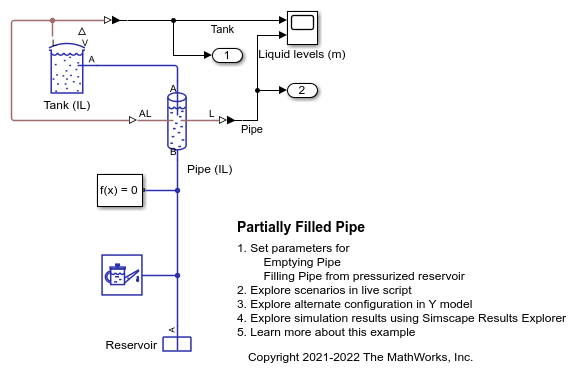Tank (IL)
Tank in an isothermal liquid system
Libraries:
Simscape /
Fluids /
Isothermal Liquid /
Tanks & Accumulators
Description
The Tank (IL) block models a container with up to six input ports, A through F, within an isothermal liquid system. The tank outputs fluid volume at port V and fluid level at port L as physical signals. The block models the hydrostatic pressure difference between the liquid surface and the inlet height level. The tank can be pressurized to a constant, user-specified value or to atmospheric pressure.
Fluid Volume
The volume of fluid in the tank is determined from the total mass flow into the tank:
where:
M is the total mass in the tank supplied by all ports.
ρ is the fluid density.
Due to the constant pressure in the tank, the liquid volume inside the tank changes based on mass flow rate. Note that the converse is true for pipes, where pressure is a function of fixed fluid volumes.
If the tank fluid volume exceeds the specified capacity of the tank, you can
choose to be notified. Set the Liquid volume above max capacity
parameter to Warning if you would like to receive a
warning when this occurs during simulation. Set the parameter to
Error if you would like the simulation to stop when
this occurs.
Fluid Level
If Tank volume parameterization is set to
Constant cross-section area, the fluid level in the
tank is determined from the fluid volume V, due to the constant
cross-sectional area of the tank. Otherwise, the fluid level can be specified as
tabulated data in the Tabulated data - volume vs. level
option.
When the level in the tank falls below the inlet height, the assumption that fluid entirely fills the volume of the connecting blocks may not be valid. Connections to a Pipe (IL) block, which is based on this assumption, may in this case return unphysical results. If you expect to model tank fluid levels below tank inlet height(s), connect the Tank (IL) block to your system with a Partially Filled Pipe (IL) block instead.
Like the Liquid volume above max capacity parameter, you can be notified if the tank fluid level falls below the height of the inlet port(s) during your simulation by changing the Liquid level below inlet height parameter setting.
Mass Flow Rate
If you set Number of inlets to a number greater than
1, the equations below apply to each port. The dynamic
pressure for an inlet port, i, is
where:
ρi is the fluid density.
vi is the flow velocity.
is the mass flow rate into the tank fluid volume through the port.
The total pressure is
where:
P is the value of the Tank pressurization parameter if the Pressurization specification parameter is
Specified pressure. Otherwise, P is the atmospheric pressure.Δpelev,port is the hydrostatic pressure difference at the specified port Inlet height: , where L is either the difference in height between the fluid level and the inlet height or zero, whichever is larger.
Variables
To set the priority and initial target values for the block variables prior to simulation, use the Initial Targets section in the block dialog box or Property Inspector. For more information, see Set Priority and Initial Target for Block Variables.
Nominal values provide a way to specify the expected magnitude of a variable in a model. Using system scaling based on nominal values increases the simulation robustness. Nominal values can come from different sources, one of which is the Nominal Values section in the block dialog box or Property Inspector. For more information, see Modify Nominal Values for a Block Variable.
Examples
Assumptions and Limitations
When you set the Pressurization specification parameter to
Variable pressure, the block assumes that variation in pressure occurs slowly and there is no pressure derivative in the mass and energy balance equations.

